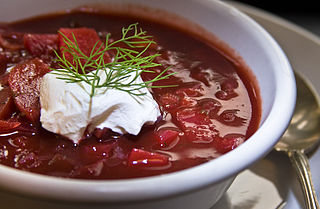
Borscht is a sour soup, made with meat stock, vegetables and seasonings, common in Eastern Europe and Northern Asia. In English, the word borscht is most often associated with the soup's variant of Ukrainian origin, made with red beetroots as one of the main ingredients, which give the dish its distinctive red color. The same name, however, is also used for a wide selection of sour-tasting soups without beetroots, such as sorrel-based green borscht, rye-based white borscht, and cabbage borscht.

Shashlik, or shashlyck, is a dish of skewered and grilled cubes of meat, similar to or synonymous with shish kebab. It is known traditionally by various other names in the Caucasus, Eastern Europe and Central Asia, and from the 19th century became popular as shashlik across much of the Russian Empire and nowadays in the Russian Federation and former Soviet Union republics.

Pierogi or pierogies are filled dumplings, made by wrapping unleavened dough around a filling, and occasionally flavored with a savory or sweet garnish, finally cooked in boiling water.

Pâté is a forcemeat. Originally, the dish was cooked in a pastry case; in more recent times it is more usually cooked without pastry in a terrine. Various ingredients are used, which may include meat from pork, poultry, fish or beef; fat, vegetables, herbs, spices, wine and brandy.
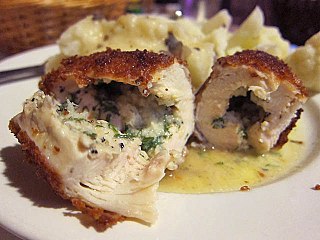
Chicken Kiev, also known as chicken Kyiv, is a dish made of chicken fillet pounded and rolled around cold butter, then coated with egg and bread crumbs, and either fried or baked. Since fillets are often referred to as suprêmes in professional cookery, the dish is also called "suprême de volaille à la Kiev". Stuffed chicken breast is generally known in Russian and Ukrainian cuisines as côtelette de volaille. Though it has disputed origins, the dish is particularly popular in the post-Soviet states, as well as in several other countries of the former Eastern Bloc, and in the English-speaking world.

Sorrel soup is made from water or broth, sorrel leaves, and salt. Varieties of the same soup include spinach, garden orache, chard, nettle, and occasionally dandelion, goutweed or ramsons, together with or instead of sorrel. It is known in Ashkenazi Jewish, Belarusian, Estonian, Hungarian, Latvian, Lithuanian, Romanian, Armenian, Polish, Russian and Ukrainian cuisines. Its other English names, spelled variously schav, shchav, shav, or shtshav, are borrowed from the Yiddish language, which in turn derives from Slavic languages, like for example Belarusian шчаўе, Russian and Ukrainian щавель, shchavel, Polish szczaw. The soups name comes ultimately from the Proto-Slavic ščаvь for sorrel. Due to its commonness as a soup in Eastern European cuisines, it is often called green borscht, as a cousin of the standard, reddish-purple beetroot borscht. In Russia, where shchi has been the staple soup, sorrel soup is also called green shchi. In old Russian cookbooks it was called simply green soup.

Vorschmack or forshmak is an originally East European dish made of salty minced fish or meat. Different variants of this dish are especially common in Ashkenazi Jewish and Finnish cuisine. Some varieties are also known in Ukrainian, Polish and Russian cuisine.

Bublik is a traditional Eastern European bread roll. It is a ring of yeast-leavened wheat dough, that has been boiled in water for a short time before baking.
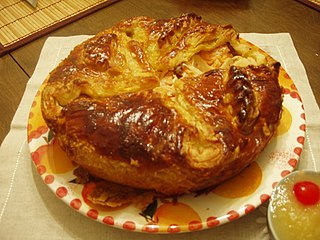
Pirog is a baked case of dough with either sweet or savory filling. The dish is common in Eastern European cuisines.
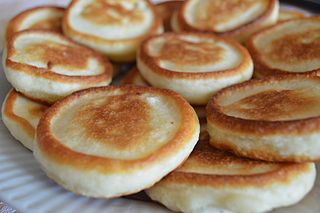
Oladyi are small thick pancakes or fritters common in Russian and Ukrainian cuisines. The batter for oladyi is made from wheat or buckwheat flour, eggs, milk, salt, and sugar with yeast or baking soda. The batter may also contain kefir, soured milk or yoghurt. Oladyi may also include various additions, such as apple or raisins.
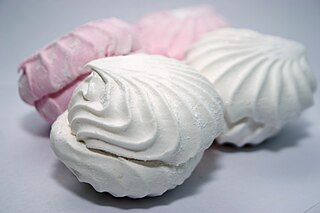
Zefír is a type of soft confectionery made by whipping fruit and berry purée with sugar and egg whites with subsequent addition of a gelling agent like pectin, carrageenan, agar, or gelatine. It is produced in the countries of the former Soviet Union. The name given after the Greek god of the light west wind Zephyr symbolizes its delicate airy consistency.
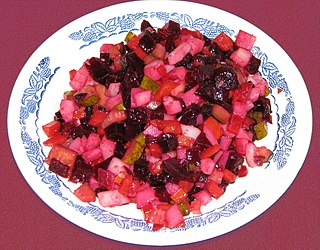
Vinegret or Russian vinaigrette is a salad in Russian cuisine which is also popular in other post-Soviet states. This type of food includes diced cooked vegetables, chopped onions, as well as sauerkraut and/or brined pickles. Other ingredients, such as green peas or beans, are sometimes also added. The naming comes from vinaigrette, which is used as a dressing. However, in spite of the name, vinegar is often omitted in modern cooking, and sunflower or other vegetable oil is just used. Some cooks add the brine from the pickled cucumbers or sauerkraut.

Varenye is a popular whole-fruit preserve, widespread in Eastern Europe, as well as the Baltic region. It is made by cooking berries, other fruits, or more rarely nuts, vegetables, or flowers, in sugar syrup. In some traditional recipes, other sweeteners such as honey or treacle are used instead of or in addition to sugar.
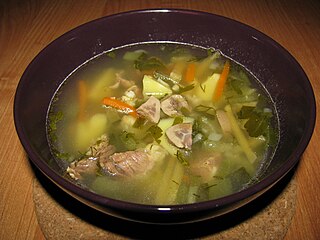
Pickle soup is a style of soup prepared with various types of pickled vegetables. Dill pickle soup is a variety of pickle soup prepared with pickled cucumber. Some versions use grated dill pickle in their preparation. Some restaurants in the United States offer the dish to their patrons, such as Polish grocery stores and restaurants in Chicago's south side.

Ryazhenka, or ryazhanka, is a traditional fermented milk product in Belarus, Russia, and Ukraine. It is made from baked milk by lactic acid fermentation.

Peremech is an individual-sized fried dough pastry common for Volga Tatar and Bashkir cuisines. It is made from unleavened or leavened dough and usually filled with ground meat and chopped onion. Originally, finely chopped pre-cooked meat was used as a filling, but later raw ground meat became more common. Alternatively, peremech can be filled with potato or quark.
Manifesto to the Ukrainian people with ultimate demands to the Ukrainian Rada is an official document of the Council of People's Commissars of the Russian Soviet Federative Socialist Republic, prepared by Chairman of the Council of People's Commissars Vladimir Lenin, People's Commissar for Foreign Affairs Leon Trotsky, People's Commissar of Nationalities Joseph Stalin.

Medivnyk or medovyk іs a Ukrainian honey cake.



















